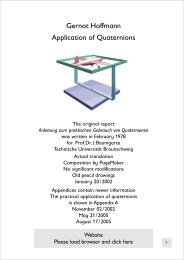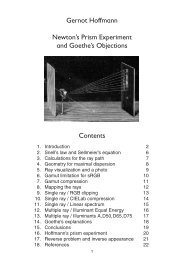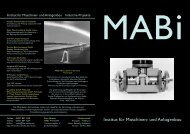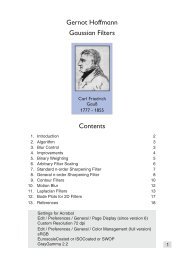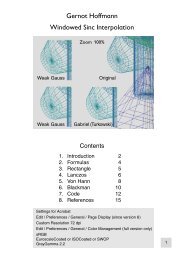Gernot Hoffmann Casa Munsell
Gernot Hoffmann Casa Munsell
Gernot Hoffmann Casa Munsell
Create successful ePaper yourself
Turn your PDF publications into a flip-book with our unique Google optimized e-Paper software.
<strong>Gernot</strong> <strong>Hoffmann</strong><br />
<strong>Casa</strong> <strong>Munsell</strong><br />
29. Juni 2012
Das Originalbuch enthält 40 Tintenstrahldrucke auf Japanpapier. Alle zeigen<br />
dasselbe Gebäude – eine Toilette an einem Strand in Portugal (Bild rechts).<br />
Das Foto wurde mit Adobe Illustrator automatisch in 40 Grafiken verwandelt,<br />
basierend auf 40 <strong>Munsell</strong>-Tafeln oder -Paletten. Die Tafeln des <strong>Munsell</strong>-Farbatlas‘<br />
kann man sich fächerartig an der Achse eines Zylinders befestigt vorstellen,<br />
von 0° bis 351° in 9°-Schritten. In der Illustration rechts unten sieht man<br />
zwei kombinierte Tafeln aus dem Dokument The Digital <strong>Munsell</strong> [1] des Autors,<br />
das auf Daten von Roger Breton (private Information) basiert.<br />
Die rechte Tafel zeigt einen Farbton Rot bei 0° und die linke einen Farbton Cyan<br />
bei 180° (Komplementärfarben). Auf der Mittelachse liegen die Grautöne.<br />
Eine Palette gilt also immer für einen Farbton. In vertikaler Richtung nimmt die<br />
Helligkeit zu, in radialer die Sättigung. Die Grautöne wurden nicht für die Umwandlung<br />
verwendet, außer für die Graugrafik a02. Das letzte Bild b42 ist auch<br />
eine Ausnahme. Es zeigt die Umwandlung mit angepaßten Farben statt einer<br />
Palette mit nur einem Farbton. Hinzu kommt das Titelblatt. Das Buch enthält<br />
somit insgesamt 43 Drucke.<br />
Der Tintenstrahldrucker wurde für das Japanpapier kalibriert. Ein solches<br />
Medium kann keinen großen Farbenvorrat (Gamut) wiedergeben. Gesättigte<br />
Farben werden weniger brillant dargestellt, was zum Konzept gehört.<br />
Die Umwandlung mit Illustrator nennt man Tracing. Eine Rastergrafik wird<br />
durch ein Flickwerk von Flächen mit jeweils konstanter Farbe ersetzt. Man erhält<br />
eine Vektorgrafik mit dem erwünschten Effekt der Posterisierung.<br />
Vielen Dank an Monika Siebert (Emden) für die schöne und akkurate Buchbindearbeit.<br />
Für die optimale Darstellung bitte Adobe Reader oder Acrobat so einstellen.<br />
Auch aktuell Zoom 100% verwenden.<br />
Edit > Preferences > Page Display<br />
Zoom 100 %<br />
Custom Resolution 72 ppi statt 96 ppi<br />
Edit > Preferences > Color Management<br />
RGB sRGB Standard<br />
Deutsch<br />
Originalfoto<br />
180o 5BG<br />
5R<br />
10<br />
V<br />
9<br />
8<br />
7<br />
6<br />
5<br />
4<br />
3<br />
2<br />
1<br />
0<br />
16 C 14 12 10 8 6 4 2<br />
2 4 6 8 10 12 14 C 16<br />
Zwei <strong>Munsell</strong>-Tafeln, vereinigt in einem Diagramm [1]<br />
0 o
The original book contains 40 inkjet prints on Japan paper, showing always the<br />
same building – a public toilet on a beach in Portugal, image top right.<br />
The photo was automatically converted by Adobe Illustrator into graphics,<br />
based on 40 <strong>Munsell</strong> tables or palettes.<br />
The <strong>Munsell</strong> atlas consists of 40 <strong>Munsell</strong> tables, which can be fixed at the axis of<br />
a cylinder like a fan in the space at angles from 0° to 351° by steps of 9°.<br />
The illustration bottom right shows two combined tables in the author´s document<br />
The Digital <strong>Munsell</strong> [1], which is based on private data by Roger Breton.<br />
The right table shows a certain red at 0° and the left one a certain cyan at 180°,<br />
the complementary colors. The middle axis contains <strong>Munsell</strong> grays.<br />
One palette is valid for one hue. Vertically the lightness is increasing and radially<br />
the saturation. The gray values were not used for the conversion, except<br />
for the gray graphic a02. The last graphic b42 is also an exception, it shows the<br />
conversion with adapted colors instead of using a single-hue palette. Together<br />
with the title graphic, the book contains 43 prints.<br />
The inkjet printer was calibrated for the special Japan paper. It is obvious that<br />
such a medium cannot reproduce a large gamut, which means that saturated<br />
colors appear less brilliant. That is in fact a part of the concept.<br />
The conversion by Adobe Illustrator is called Tracing. A raster graphic can be<br />
substituted by a patchwork of areas with locally invariable colors. The result<br />
is called vector graphic, opposed to raster graphic, but more important is the<br />
intended effect of posterization, based on a given palette with few colors.<br />
Many thanks to Monika Siebert (Emden) for binding the book accurately and<br />
beautifully.<br />
[1] The Digital <strong>Munsell</strong><br />
http://www.fho-emden.de/~hoffmann/munsell15052009.pdf<br />
[2] This doc<br />
http://www.fho-emden.de/~hoffmann/casamunsell24062012.pdf<br />
Please use Zoom 100% and in Adobe Reader or Acrobat settings as shown on<br />
previous page.<br />
English<br />
Original photo<br />
180o 5BG<br />
5R<br />
10<br />
V<br />
9<br />
8<br />
7<br />
6<br />
5<br />
4<br />
3<br />
2<br />
1<br />
0<br />
16 C 14 12 10 8 6 4 2<br />
2 4 6 8 10 12 14 C 16<br />
Two <strong>Munsell</strong> tables combined in one diagram [1]<br />
0 o



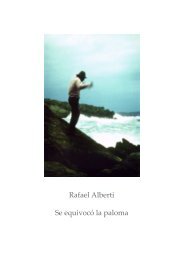
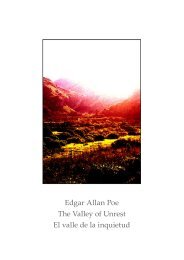

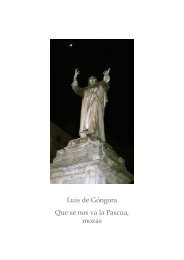
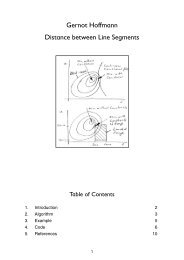
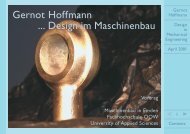
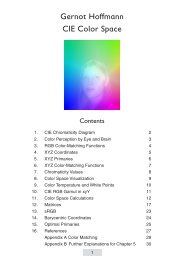
![[PDF] SpieleProgrammierung](https://img.yumpu.com/6860251/1/190x135/pdf-spieleprogrammierung.jpg?quality=85)
